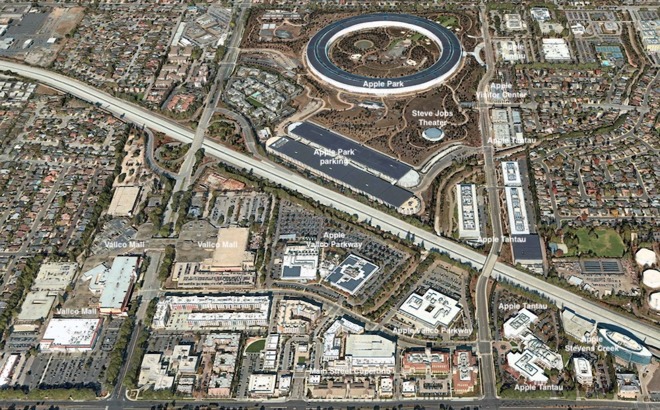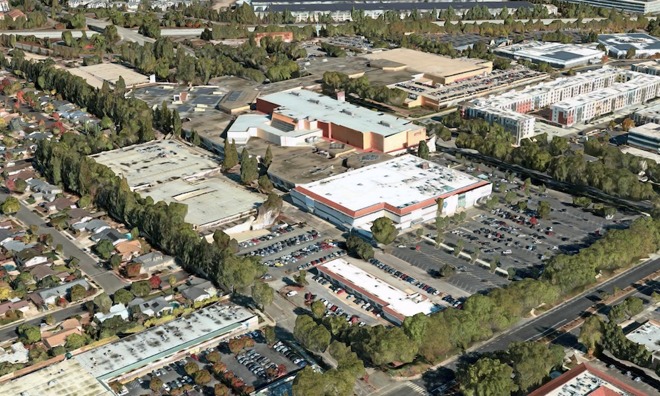As thousands of Apple employees begin moving into new offices at the company's new "Campus Two" at Apple Park, development battles over a new project next door are enlisting their support to build more housing in the quiet Silicon Valley town that's been the corporate home of Apple since its founding.

The largely dead Vallco Shopping Mall (below) lies directly across the freeway from Apple Park. It is the subject of ambitious plans to rebuild the retail graveyard into what could be a vibrant new mix of retail, offices and housing.
Cupertino's government, however, is frowning at building any new housing (during a severe shortage of places to live in the region) because it gets more tax revenue from office space. Apple's local taxes alone fund around 30 percent of the town's budget.
Vallco Mall and its sprawling parking lots sit next to a series of Apple's existing Vallco Parkway offices, including new space the company now leases next to the recently built "Main Street Cupertino" project, which actually does involve both new offices and some housing.

Apple and the Mall
The large indoor mall, which bridges over Wolfe Road, is about as old as Apple itself: built in 1976 as Americans were fleeing the cities to pave over surrounding farmlands in order to build out the sprawl of suburbia.
This move created the Petri dish of Silicon Valley, where kids like Steve Jobs and Steve Wozniak were raised in safe communities of middle-class families, with the ability to pursue their curiosities--taking advantage of specialized technical education and job opportunities at the region's founding technology firms, including Atari and Hewlett Packard (the latter of which paved over the orchards and occupied the land where Apple Park now sits) and even found their own new companies.
In the mid-80s, Vallco Mall, originally called "Vallco Fashion Park," began facing new competition from more modern shopping centers. Like Apple itself, the mall attempted to refresh and expand itself to remain competitive. However, in the 1990s it was hit by a series of forces, including the emerging role of online retailers and the fact that increasingly affluent demographics in Silicon Valley weren't attracted to its midrange tenants.
In 2007, as Apple released the iPhone, Vallco Mall added a new 16 screen theater and a bowling alley. By 2015, the decline of retail prompted its owners to come up with new plans to demolish the entire thing and rebuilt a modern mix of shopping, offices and housing on a street grid covered with green parks, orchards and gardens.
The project was called The Hills of Vallco. The planning site (portrayed in a rendering below) would be directly opposite from Apple Park's garages (top of the image) and across the street from the company's Vallco Parkway 2A building (top right).
However, homeowners concerned that any new housing might affect the stratospheric valuation of their own property (in a city where a standard family home is priced in the millions) rushed to kill plans for any new housing. Two competing measures, one to block the construction of anything on the site apart from retail, and another to push through the original The Hills of Vallco plan without the risk of it being derailed by opponents leveraging the city planning process, both failed to pass in 2016.
In the year since, things have only gotten worse for Vallco Mall as its large anchor stores (formerly Sears, Macy's and JC Penney) remained abandoned and its interior walkways lead to little more than empty retail stores and a few random low-rent tenants. Its owners have announced that they have no interest in trying to spruce up the site because it demands a larger investment to create something new.
Homeowners are still trying to block any new housing, asking that the old mall only be replaced by a new shopping center, despite the fact that there is clearly no real demand for a shopping center in Cupertino.
At this point, Vallco could probably best serve as an opportunity for Apple to take over the property and use it for expansion of its existing Vallco offices. But housing advocates are asking Apple's workers--most of whom can't afford to buy housing in Cupertino even with professional salary--to push for new housing on the site. At the currently insane housing prices of Silicon Valley, a couple of Apple employees trying to buy a house in Cupertino would face a mortgage of around $10,000 per month
At the currently insane housing prices of Silicon Valley, a couple of Apple employees trying to buy a house in Cupertino would face a 20 percent down payment on an existing home at a price even higher than greater SV's median of $1.17 million, meaning they'd also have to pay a mortgage of around $10,000 per month. And there are only a couple dozen available houses for Apple's thousands of employees to even attempt to buy anywhere near the company's offices.
That prompts much of Apple's workforce to commute from more affordable (or at least more desirable) areas, including San Francisco, around 40 minutes away when there isn't any traffic. Apple has worked to develop a network of buses to minimize the impact of traffic because the Bay Area suburbs lack much effective transit of their own.
Some residents in desirable areas of San Francisco served by buses from Apple (and other firms in a similar predicament, including Google) have demonized the influx of new workers as a gentrifying force, as if the City would be better off in an economic decline, with the kind of violent crime and decay that San Francisco limped through in previous decades of lower rents.
San Francisco also faces a long-term housing shortage, in part because activists there, as in Cupertino, work to block the development of any new housing (particularly any housing density), fearing that any new housing would be filled with some sort of undesirables.
Are you an Apple employee who works in Cupertino? Take this survey to tell this NIMBY group down there that you want housing on this 50-acre failed mall site less than a mile from Apple HQ: https://t.co/STrrUerok4 (And then also attend the meetings listed below.) pic.twitter.com/aq2z0Hnwmg
-- Kim-Mai Cutler (@kimmaicutler) January 29, 2018
While no panacea, the redevelopment of Vallco Mall as a place for people to live, work and shop could at least help reduce the need for long-distance commuting and further shifts that displace people and raise rents elsewhere.
For that reason, Apple employees have been encouraged to get involved in planning discussions that begin next Monday, February 5, and to weigh in on a survey that asks what individuals think should be built at the Vallco site.
That survey, set up by Better Cupertino, is currently tilted to support the anti-housing efforts that backed the measure to block anything from being built on the site apart from more retail. However, only a couple hundred people have yet responded to it.